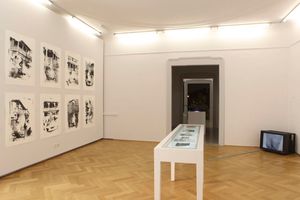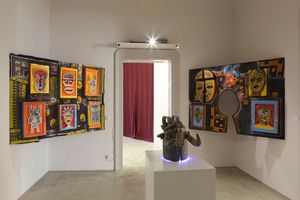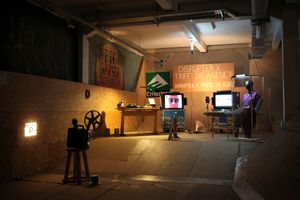Mashup the Archive
2015
Mashup The Archive - Introduction - Sam Hopkins And Nadine Siegert
Originally published in Sam Hopkins and Nadine Siegert (eds), Mashup the Archive. Revolver, Berlin: 2017
In the town of Bayreuth, located in Upper Franconia, Northern Bavaria, Southern Germany, there is a house, a space and an environment dedicated to the research and exhibition of modern and contemporary African art; the Iwalewahaus. The archives of the Iwalewahaus reveal, and seal, a rich and variegated collection, from modernist artists El Anatsui and Ibrahim El-Salahi to sign paintings by Congolese and Nigerian artists such as Moke and Middle Art, to one of the biggest museum collections of 1990s Nollywood VHS tapes, to a vast slide collection of camels from the German ethnographer Gerd Spittler, to name but a few. The history of the institution is as detailed and textured as its collections that are themselves a manifestation of the interests, tastes and predilections of its former directors. But there has always been one constant: its location. It is not of course that Bayreuth is provincial, but that it is in Germany. This unique and idiosyncratic collection of cultural production is located far away from where most of these objects were produced, many of which are produced by artists and artisans living in countries on the African continent.
Mashup the Archive was a project at the Iwalewahaus between 2013 and 2015 that incorporated two mini festivals and culminated in an exhibition and a series of events and roundtables. It is is part of an ongoing approach of the institution to critically engage with the appropriation, possession and collecting of art from “elsewhere”. Unlike many of its museum counterparts, the objects in the collections were not taken by force nor obtained in dubious circumstances during the colonial period. Nevertheless, there is a whole set of problematics surrounding the practice of European institutions collecting modern and contemporary African art, not least the patronage relationships between the collectors and the artists. Of primary importance today is who can access this archive and therefore who can produce knowledge from this material. In the case of the Iwalewahaus it has largely, although not exclusively, been academics from Europe. Even if a large part of the collections is inventoried and digitized, the digital database feels like a blunt tool.
The core idea behind Mashup the Archive was a curatorial intervention into the archive. Both curator and artists, most of them based on the African continent, cruised the collections, motivated by intrigue and curiosity about the archive. The idea was to kind of circuit-bend the institution, to wire it up in ways in which had not been experimented with before. To connect artists, artists' research strategies, artists' approach to knowledge and knowledge production, with the archival objects. Mashup became the central method and metaphor for this process. Mashup is a term that derives from digital culture and is often used to describe a practice of combining disparate elements from different sources, usually music, software or moving image to create a new entity.
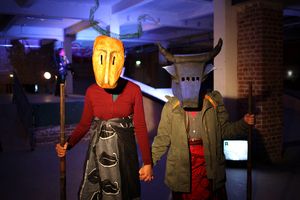
Our idea was to recombine elements of the archive, to establish new connections between the objects, to disturb relationship between the object and its index, to produce the archive anew. The index became the central point for a critical reflexion, since it became clear that the thesaurus used for the indexing of the objects is limited in its Eurocentric features. It simply does not allow the inclusion any artistic perspectives that go beyond the museological logic of the Western museum.(1) The digital database (DEVA – Digitalisierung, Edition, Vernetzung), a central pillar of the archive and the manifestation of this limited logic was therefore under close scrutiny.
Together with the Kenyan digital solutions agency, Circle Digital, we developed a new prototype database to explore these taxonomical limitations. All exciting ideas, but this was a limited and humble gesture; 10 artist residencies over 2 years is a small window of access to the archive. It is also a compromised gesture; inviting artists to work in an archive involves various chapters of institutional negotiations. However, the works that emerged from this process reveal depths, perspectives and dimensions to the archive, which would otherwise have been invisible.
There is a real formal diversity amongst the works produced, and a whole constellation of practices, but there is a palpable shared concern with narrative. This is perhaps most deliberately articulated in the anti-opera of Thenjiwe Niki Nkosi and Pamela Phatsimo Sunstrum, but is also present in the experiential environments of Kevo Stero and Otieno Gomba, the ‘documents’ of Delio Jasse, the obsessive shredding of Uche Uzorka, the meditative book project of Simon Rittmeier, the playful animations of Miss Eve, the hypnagogic visuals of Nita., the meta beats of Batida and the visceral dance music of DJ Raph. The archive became a site of multiple new combinations; it suddenly seemed willing and able to enable new semantic readings.
The armature of this reader is a series of interviews with the artists, in which they talk about their personal approaches, responses, feelings, reservations and engagements with the archive. The narrative sensibility that we see in the works of the artists is further testified to here, in various ways. There is the storytelling of Niki Nkosi and Sunstrum who picked objects 'from the heart' before arriving in Bayreuth, and developed an imaginary story around them, consciously deciding not to know their archival description (provenance, object biography etc). In the approach of Jasse, who describes the archive like a 'secret box' there is more of a feeling of translation; the archive as old images that he overlaps and layers and therefore tell new stories with his palimpsests. This idea is picked up by Stero who took on a role to 'recycle' the archive for the present.
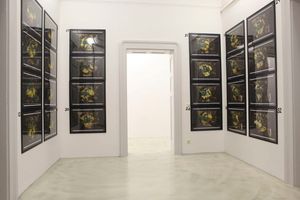
Then there are the artists who explore ideas of custodianship; Uzorka tempers Stero's perspective of resilience with his idea of the archive existing in a state of vulnerability and that to 'fulfil the agency of an archive is to create further vulnerability around it'. It is rather the archives power that Nita. feels, sensing an aura emanating from it, and that in every object, 'every single fragment and patina' tell a story. Working with this material, as an artist, is a matter of respect. Similarly Gomba talks of how he felt very 'attached to the masks' with which he was working, that he sensed their 'spiritual' purposes. Some of these interviews, evidence a more somber position, investigating notions of recuperation; it is rather the 'forgotten (his)stories' which concern Rittmeier, who meditates on loss and absence in his interview. Miss Eve maintains that these stories and this information is critical 'in filling in the puzzle pieces to what African history really is'. This desire, to know 'the backstory' of the music is echoed by DJ Raph; not knowing it he is compelled to work with what he describes as the 'aesthetics' of the music. Batida, by contrast, investigates the physical space of the archive and the materiality of the objects, exploring the contemporary life of the archive through its 'literal interactions' on visitors.
In these testimonies there is a strong sense of an emotional and sensual approach to the archival material. Narrative plays various roles here; to counter established meanings and knowledge, to re-write a story, to nuance the scientific information of the archive, to supplement a one-sided epistemology. Seen as a group, there is no consensual refusal to translate the archive, nor a comprehensive veto to act as interlocutors. A series of curatorial texts are positioned in dialogue with these interviews, which refine and augment the artists' own positions and their practice. By situating the techniques of DJ Raph and Batida, in this case one sampling the content of the archive one sampling its physical space within a history of electronic music production, Alexandra Kuhnke reveals how they both set up an interplay between old and new in their music. Similarly, Katharina Greven's detailed observation of Jasse's singular technique of analogue and digital photo manipulation opens up a series of questions on representation, truth and memory that orbit his practice. Other essays alert us to artistic intention. Lucie Ameloot and Lena Naumann's essay on the work of Gomba and Stero recast their seemingly irreverent interventions into the archive as acts of veneration, intended to re-activate and re-vitalise the ritual objects. Whilst the shredded documents of Uzorka might suggest that his position on the archive is one of rejection and destruction, Siegrun Salmanian's text alerts us to the issues of transformation and accessibility, which concern him.
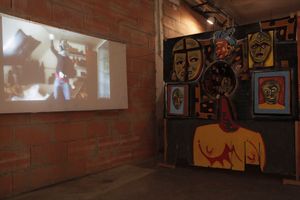
The formal and graphic dimensions of Miss Eve's work immediately strike the visitor, but Paola Solís Arana suggest that it is issues of provenance and knowledge that underpin this practice. Anisha Soff muses on the challenges of exhibiting a performative work, and how the exhibition parameters for Niki Nkosi and Sunstrum, who simultaneously showed iterations of the work in Bayreuth and Johannesburg, made legible the dense layering of fiction and real in the piece. Fabian Lehmann opens up the process of conceiving and constructing the digital database by Circle Digital, through a speculative analysis on the digital archive using Foucault's legendary essay 'Of Other Spaces'. A theoretical framework which informed the artist book Letter to Lagat enables Susanne Gerhard to re-imagine objects as agents, recasting their role and relationship in the archival ecosystem.
Interspersed within these essays and interviews are eight further texts, which meditate more broadly on ownership, object and original within archives during the digital era, and the strategies artists and museums are employing within this matrix. Some of these essays explicitly engage with the artworks in the Mashup exhibition. Mark Nash responds to several works and positions within the exhibition that orbit around issues of 'subjectivity', ruminating on notions of practice and scholarship viewed through a subjective lens. Beatrice Ferrara charts a genealogy of opacity within diasporic Black culture, speculating on the ways in which artists in the Mashup project are translating the archive, yet are speaking 'in tongues'. Eduardo Navas situates the work of the artists in Mashup within a taxonomy of Mashup practices, and he explores legitimacy and 'dividual agency' within the works of the artists. Nina Huber applies the analytical framework of Eduardo Navas to the methodology of the Weltkulturen Museum testing ideas of sampling, remix and mashup in relation to recent approaches and works there. Other essays focus more on alternative case studies, situating Mashup within a broader critical framework. Celeste Ianicello and Lotte Arndt both draw on artistic propositions. Ianiciello discusses the work of Kader Attia and the Askavusa Collective, investigating techniques of re-appropriation employed to re-configure an identification with a corpus of objects. Arndt casts her attention to the work of Sammy Baloji at Mu.ZEE as a kind of inverted version of the Mashup exhibition; an intervention into a classical art institution through the strategic insertion of colonial documents. Ugochukwu-Smooth Nzewi and David Dibosa focus rather on approaches and strategies of the museum. Nzewi outlines a history of institutional critique in North America, citing the seminal work of Fred Wilson and extrapolating the ideas of Karp and Levine within recent museal practice. Dibosa starts with a conundrum of whether or not to visit a significant exhibition of objects whose ownership is strongly contested, moving on to outline a proposal for unlocking ownership battles via inter-museum trust and reciprocity.
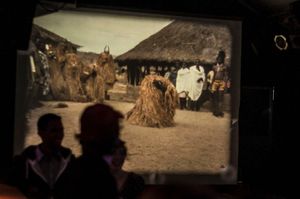
Some conversations with the curator and additional texts by the artists add to this multivocal endeavour to stir the archive and its logic. All these texts emerged over the two-year gestation period of the project, showing a certain conceptual development of the project and the continuous reflection on limits and legitimacies. But they also capture moments of elucidation that have often been connected to moments of aesthetic experience, such as a club night in the first Mashup festival.
As a collection of texts this writing employs a range of register, style and argumentation to approach the core questions of the Mashup project. Do these story-infused artworks manage to interrogate the legitimacy of archival institution? Can these works simultaneously question the institution yet revel in the qualities of the original archival objects? Do artistic strategies of irony and irreverence effect a displacement of power? Could we even say that Mashup, beyond being a curatorial intention and a set of artistic practices is a sensibility? Or the aspiration for a sensibility? A sensibility towards compromised archival objects, a way of treating things, which are spoken for by a flawed system, simultaneously acknowledging and ignoring that system. An attempt to navigate not only discursively and conceptually, but sensitively and sensually.
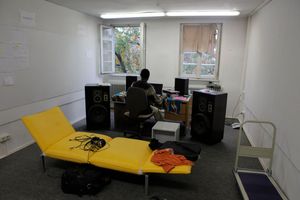
Notes:
- Here we are indebted to a lecture at the Iwalewahaus by Vladimir Cajkovac on July 28, 2014 in which he discussed the problematics of indices and archival systems he encountered in his research at the Deutsches Hygiene Museum in Dresden
The Iwalewahaus: Displaying Works of African Modernism - Nadine Siegert
It’s called MashUp - The Art of Iwalewahaus Bayreuth (video)
download text as PDF